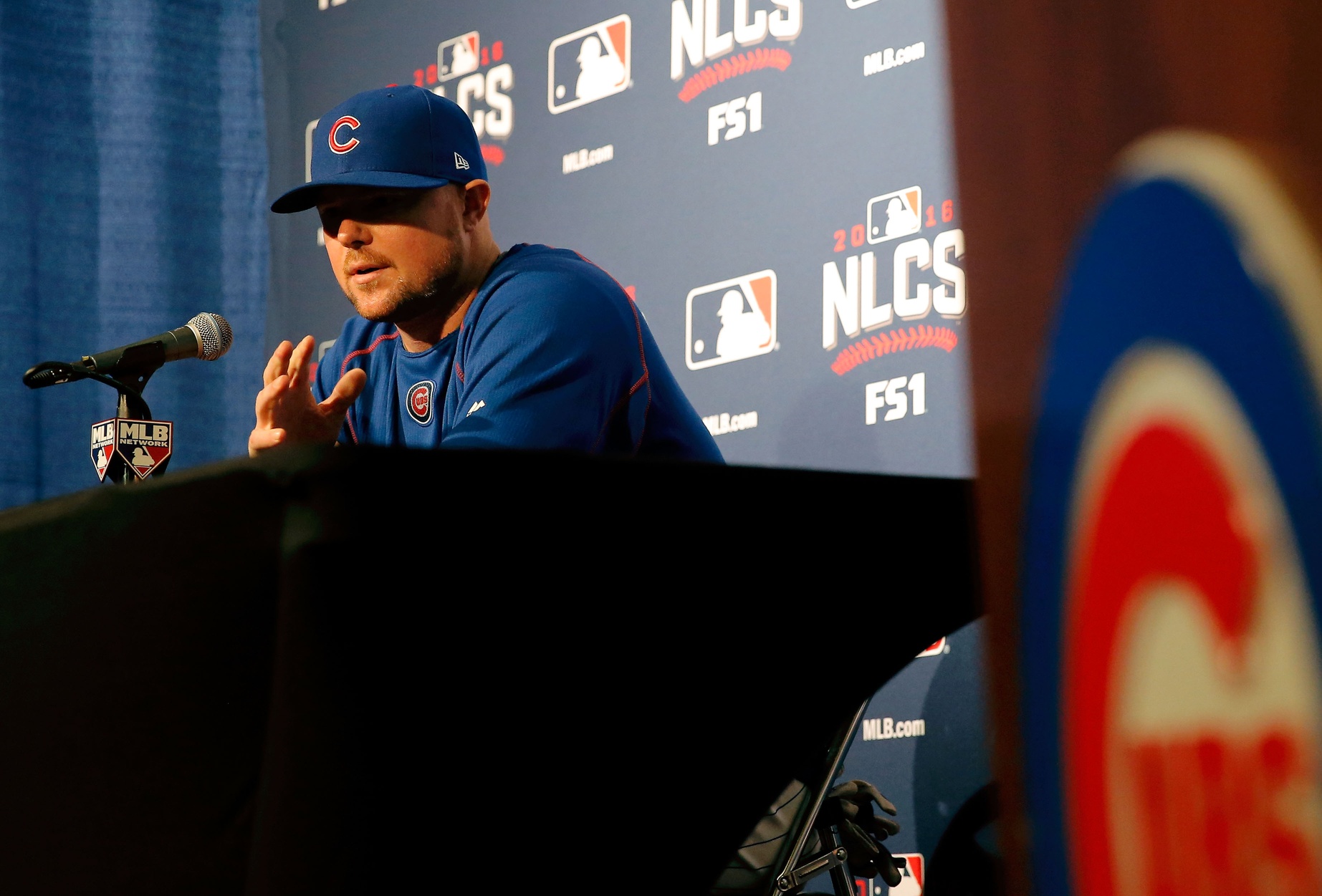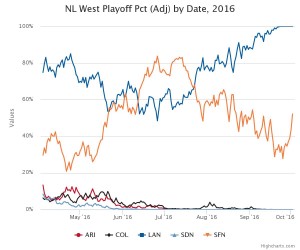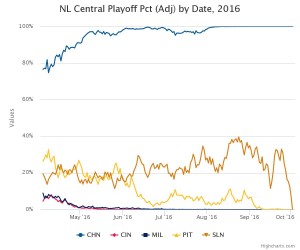This piece, written by BP Wrigleyville’s Jared Wyllys, forms part of our in-house coverage of the Cubs in the playoffs, “Second City October”. Additional NLDS coverage, written by Aaron Gleeman and originally run on the main site’s series “Playoff Prospectus,” can be found here.
Fortune has not been kind to the Cubs when they travel to the west coast, and especially so in the playoffs. This season has defied history many times already, sure, but in Chicago more than perhaps any other city there is an attachment to what’s happened in the past, especially the failures. So while it might be tempting to conjure up the ghosts of playoffs past in which the Cubs went west and returned empty-handed, these things do nothing to inform anyone about what might be expected in this year’s NLCS matchup with the Dodgers, and the regular season outcomes of the past two seasons against Los Angeles actually offer some encouragement for Cubs fans.
This is a Dodgers team that has been rife with drama as it is this season—an icon retiring from the booth, a former superstar designated to Triple-A Oklahoma and then returning again, their ace shelved by injury for two months—to say nothing for how they packed another season’s worth of memories into their NLDS Game Five win on Thursday night. Los Angeles manager Dave Roberts spared nothing to get this far, and he may have to reach even deeper to advance from here. While the Cubs starting pitching staff has had since Tuesday night to rest and be realigned for this series, Roberts employed every arm he could get his hands on to get past the Nationals just two days ago. In just Thursday’s game, this meant using Rich Hill, Julio Urias, and Clayton Kershaw.
But before they even got to that point, they survived a season of fending off the Giants, and they now look ahead to a seven game series against the Cubs. Represented below, the regular season path to the playoffs for the Dodgers was quite a ride:
Meanwhile, even at their darkest hour (late June up to the All-Star break) the Cubs’ march to October was comparatively tranquil:
Both teams come into the championship series now on the heels of epic finishes in their divisionals. The Cubs defied WPA going into the ninth inning on Tuesday in a way that had not been done in thirty years, and the Dodgers staved off the Nationals with the aforementioned unorthodox rotation of pitchers Thursday night. With that in mind, let’s look at what Los Angeles brings to the table:
Starters (Handedness/IP/ERA/DRA)
Clayton Kershaw – L/149/1.69/2.03
Rich Hill – L/110.3/2.12/2.56
Kenta Maeda – R/175.7/3.48/3.41
Julio Urias – L/77/3.39/3.97
Because Hill, Urias, and Kershaw were all in action as recently as Thursday and Kershaw was already used on short rest more than once during the LDS, tonight’s game is Maeda’s to start. Maeda can throw hard, but his K/BB against left handed hitters suggests that Anthony Rizzo’s postseason breakout might be coming this evening.
Originally, Kershaw was then slated to go in Game Two tomorrow, but this status was in question after he was used, albeit briefly, in Game Five on Thursday. Perhaps tellingly, however, he was described as “absolutely not” available for Thursday’s game just that afternoon, so even what we think we know with certainty isn’t always a given. The postseason is a special animal, and sometimes a team has to burn the ships to advance to the next level, and sometimes they have to keep doing that as long as they need to.
It should probably be assumed, though, that Kershaw starts tomorrow night. Most recently, it’s been subtly hinted that he will be the guy in Game Two, and his outing on Thursday is being viewed as “a real high-intensity bullpen session.” Kershaw is certainly capable of a quality outing on what would technically be short rest, but it’s worth considering too that he missed a very large chunk of the season and returned only at the beginning of September.
Bullpen (Handedness/IP/ERA/DRA)
Kenley Jansen R- 68.7/1.83/1.95
Joe Blanton R- 80/2.48/4.36
Ross Stripling R- 100/3.96/4.32
Pedro Baez R- 74/3.04/3.65
And a few others. Namely, Grant Dayton, Luis Avilan, and Josh Fields. Avilan and Dayton represent the only southpaws at Roberts’ disposal, though he showed on Thursday that in an elimination situation in the postseason, he’s not averse to getting creative with starters like Urias or even Kershaw. During the regular season, this reliever corps nearly rivaled that of the Cubs. Dayton and Avilan sit in the top five on the staff in DRA, and with K/9 rates that sit at 13.33 and 12.81, respectively.
When it comes to the Cubs against this bullpen, they’ll be facing one that is much more sturdy than the one in the series prior. San Francisco’s Achilles Heel took them down on Tuesday for the want of three simple outs, but an implosion of that sort is far less likely in this series.
Hitters (Handedness/PA/TAv)
Yasmani Grandal – B/457/.299
Adrian Gonzalez – L/633/.293
Chase Utley – L/565/.273
Corey Seager – L/687/.320
Justin Turner – R/622/.309
Josh Reddick – L/167/.240 numbers represent only his time with the Dodgers in 2016
Joc Pederson – L/476/.310
Andrew Toles – L/115/.303
Other notable batters are, of course, Yasiel Puig and Howie Kendrick. Andre Ethier’s role with the team has steadily diminished, but he was included on the NLDS roster and saw two plate appearances. But at this point, Puig and Kendrick are going to play larger roles. The lineup is stacked to the left side, so it’s worth considering how Cubs starters have typically fared against lefties. Jon Lester has a slightly more favorable split to right-handed batters, but it’s very slight. He’s kept them to a .243 TAv compared to a .247 to lefties. The split for Kyle Hendricks is much more dramatic—his runs .218/.269 (right/left), and Jake Arrieta’s looks more like a left-handed pitchers’, at .207/.193. John Lackey’s splits are closer to Hendricks, as he allows a .239/.266 TAv.
***
These are really two very tough matchups for the Cubs in order to get to the World Series for the first time since World War Two.But like the NLDS, this series still looks to be set up slightly in favor of the Cubs. It offers some of the same potential snares, and some new ones—like the potential of facing Clayton Kershaw twice in this series—to go with the simple reality that while a seven game series should be long enough that the better team will consistently come out on top, baseball is also a game of the ebb and flow. Bats sometimes go inexplicably quiet for several games in a row and pitching staffs struggle to keep runners off of the basepaths for a handful of starts. Even one or two defensive miscues can be the difference. Just ask Brandon Crawford.
In the background of this series, the old bogeymen of the Cubs get center stage in the national media, and Cubs fans get reminded of silly things like darkly hued felines, foul balls to the stands in left field, and just how long it’s been since the Cubs have been World Series champions. This makes for good trivia, but it’s far less relevant to the players, many of whom are more likely to want to wash the sour taste of a four game sweep by the Mets in the 2015 NLCS. For the Cubs in the playoffs, history does matter, but not as far back as we are told to think.
Lead photo courtesy Jon Durr–USA Today Sports.


